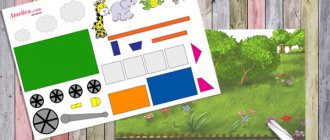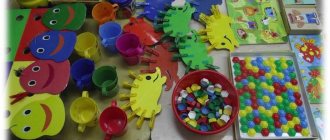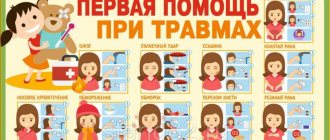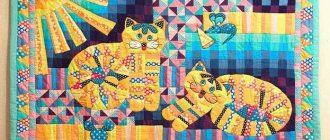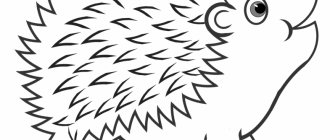How to make animal lotto yourself
Print the files, stick them on cardboard, cover the sheets with cards with tape, cut them out and you can start studying!
Educational lotto game for studying animals for children from 2,3,4,5,6 years old
Educational lotto game for studying animals for children from 2,3,4,5,6 years old
Educational lotto game for studying animals for children from 2,3,4,5,6 years old
Educational lotto game for studying animals for children from 2,3,4,5,6 years old
Educational lotto game for studying animals for children from 2,3,4,5,6 years old
Educational lotto game for studying animals for children from 2,3,4,5,6 years old
Educational lotto game for studying animals for children from 2,3,4,5,6 years old
Educational lotto game for studying animals for children from 2,3,4,5,6 years old
Didactic game “Who lives where?” lesson plan (junior group) on the topic
Didactic game
“Guess who lives where?” Goal: to develop children’s ability to correlate images of animals with their habitat, correctly naming the animal. Tasks: - explain to children what is depicted on the panel (For example: a house is depicted, which means a domestic animal lives here; the sun and unusual trees are depicted - this is a hot country; a fir-tree, a tree, a bush is depicted - this is a forest, wild animals live in the forest; a pond is depicted and cattail is a body of water in which frogs, fish, etc. live). - develop auditory perception and phrasal speech; - develop imagination when recognizing an animal. - be able, based on generalization, to correlate the image of an animal with the image of its habitat (in a pond, a domestic animal, living in the forest - a wild animal, living in a hot country); - develop the ability to express your feelings by speaking them out loud (soft, smooth, pleasant); — relieving emotional stress when feeling the pad. Preparatory stage: conversations about animals. Material used: panels depicting animal habitats; soft anti-stress pads depicting animals. Age: junior (2-3 years)
Progress of the game: The teacher draws the children’s attention to the panel. Invites children to look and say what they see. After the children’s statements, he explains: Guys, all animals have their own home. The place where he feels best. In another place he will feel bad and uncomfortable. Now I will tell you who lives and where. Pointing one by one to the image in the upper left corner: - Guys, what do you see, what is shown here? After listening to the children's answers, he continues. A house is shown here. This means that domestic animals live here - a dog, a cow, etc. What other domestic animals do you know? Children answer, and the teacher corrects correctly or incorrectly.
At the end, when all the animals are named and arranged according to their habitats, the teacher makes a generalization: - Guys, despite the fact that each animal has its own home, all animals live in a common house called Earth, like we have on our rug . The teacher, showing the animal, asks: “Who is it?” - the children guess. The teacher asks: “Where does he live?”... The child answers: “In the forest, this is a wild animal.” Asks to house this animal according to its habitat.
At the end of the lesson, the teacher lets the children play, knead the pad with their fingers and say that the children feel which pads are animals (soft, smooth, pleasant to the touch).
How to learn the names of animals with your child
1) To begin with, an adult can simply tell the child about the habitats of animals, arrange the pictures correctly and name all the animals.
2) Then select any field and cards only related to it, invite the child to arrange them independently and name them.
3) Further complicate the classes, you can play lotto. The child himself chooses which animals he will collect, you take out the pictures from the bag, the child will name them and lay out the ones he needs on the field.
My son liked this game, he couldn’t even wait quietly for me to make it, he immediately joined the process. Look at the photo for yourself.
Good luck to you and your children in studying animals!
Educational game about animals - Who lives where?
Didactic game "Who lives where"
Didactic game “Who Lives Where?”
Target:
introduce students to wild and domestic animals, who lives where, develop memory, thinking, imagination, fine motor skills, develop the ability to correlate the image of an animal with its habitat, correctly naming the animal.
Tasks:
Educational:
Expand children's ideas about the appearance, image and dwellings of nature's inhabitants. Expand your vocabulary. Develop the ability to analyze, generalize and compare, and draw conclusions.
Developmental
: Formation of the ability to recognize the image of animals in the image, to correlate the animal with its habitat. Development of visual attention and memory.
Educational:
Developing an interest in nature, caring for nature and animals.
Description of the game.
The game consists of a circle
which is divided into 8 parts (with images of animals and 8 clothespins (with the habitat of animals).
Rules.
It is necessary to correlate the animal with its habitat.
Progress of the game.
The teacher asks the student to look at the pictures, what do you see in the pictures? (animals).What types of animals are there? (wild and domestic).
Wild animals live independently in nature: they get their own food, build their own homes.
Pets are animals that have been tamed by humans by caring for them and providing them with food.
-Guys, every animal has its own house, let's help each animal find its own house.
The teacher shows an animal and asks the question “what animal is this?”
( dog).
- Is this a wild or domestic animal (this is a domestic animal). Why do you think this is a pet? (she lives next to a person, helps a person guard his home, a person feeds a dog). Then the student is asked to find a house for the animal (the dog lives in a booth).
- Well done, guys, you answered correctly and found the dog his home.
The teacher shows the next animal and asks the student a question: (the picture shows a cat.
-A cat is a wild animal or a domestic animal (is it a domestic animal). Why do you think that it is a domestic animal? (students' answers).
The student is asked to find a house for the cat (the cat lives in a special carrier)
The teacher shows a picture of a wolf and asks the question: is the wolf a domestic or wild animal (students answer the question, is the wolf a wild animal, and explain their answer (the wolf lives in a den).
Students work in a similar way with other pictures:
A camel lives in the desert
Whale in the sea
Bear in a den
Horse in the stable
Caterpillar on the bottom of a leaf.
Thus, in the process of this game, vocabulary develops and enriches, memory, thinking, imagination develops, and fine motor skills develop. The game is interesting and exciting.
Games “Who Lives Where” - project 1 day - 1 game.
- Seal
Details Author: Nalivaykina Lyudmila Published January 06, 2016
Hi all!
The “One Day - One Game” project is with you again! You can see what we played last weeks here!
This week our games will be dedicated to animals and their houses!
Ready? Then let's go!
Friday - craft on the theme “Who lives where?”
You can download a template for the craft at the end of this post... Or draw it yourself (any adult can handle a tree and a squirrel, and it doesn’t matter that the squirrel looks more like a dog, this usually doesn’t bother children very much).
Here is a squirrel sitting on a branch near a hollow... (back to the topic again - “a squirrel lives in a hollow”; you can again discuss with your child that the hollow is a squirrel’s house).
Oh! Something is wrong with the tree! Yes, it doesn’t have leaves!
Let's draw some leaves for the squirrel!
Lubricate your child's hand with paint and show him how to make handprints on wood.
You will get very beautiful foliage!
I like to do similar crafts with children from 2 to 3 years old in 2 stages:
Stage 1 - first, we draw leaves on the tree together (the mother uses the baby’s palm to draw leaves using the “hand in hand” technique) - this is how the child gets acquainted with how to do the craft.
Stage 2 - after admiring the wonderful tree that you have created, we take out another picture with a tree and a squirrel and invite the child to “decorate the tree with leaves” again, but only on his own, without your help (you can only paint the child’s palm with paint, and he can draw the leaves he can already do it himself, since he “learned” this together with you at stage 1).
In my classes at the children's club, I often suggest that children who are over 2.5 years old paint their palms with paint on their own without the help of their mothers - they also really like it.
Monday.
Let's start the week seriously! We will introduce the child to the topic “Who Lives Where!”
To begin with, I suggest you watch the presentation with your child, which you can download by clicking on the picture below.
It will be great if you can watch the presentation not only today, but several times throughout the week, so your child will better understand all the material (click on this picture ??? and you can download the presentation) .
Game after the presentation.
The child will understand the topic of the presentation very well if, after watching it, you build houses for the toy animals that you find in the house.
You can build a den for the bear and put it there for winter hibernation (wrap it in a blanket, cover it with pillows, etc.).
You can make a hole for a fox in the same way.
For a rubber fish, you can make a “sea” by pouring water into a basin.
If you think about it, you can come up with a “house” for any toy animal that you have at home!
The game “Build a house for an animal” is remarkable because children usually play it with great pleasure and it won’t take long to persuade them. At the same time, the child will not just play, but remember important and useful things: the bear’s house is called a den and he sleeps in it in winter, the fish lives in the water, etc.
Montessori Tuesday!
Look, these animals want to get home! Let's build a path for them! The bear has big legs, he will have the biggest pebbles on the path! The fox has smaller legs, the pebbles on its path will be smaller, but the squirrel has the smallest legs! Therefore, the pebbles on her path will be tiny!
The base of the path is made of dough, the “pebbles” are beans, peas, cereals (they are offered to the child in a mixed form so that he can independently dig into the cereal and look for the necessary “pebbles”). The picture can be found at the end of this post. During the game, do not forget to “pronounce” the names of the animals’ houses: we help the bear get to the “ den ,” the fox hurries to the “ burrow ,” the squirrel wants to get to the “ hollow .”
This game develops motor skills and mathematical thinking (we perform “sorting objects”), knowledge of the world around us.

